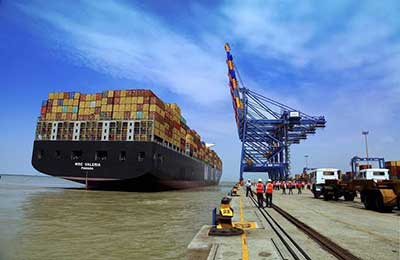Date: 10/03/2023
Relevance: GS-2: Effect of Policies and Politics of Developed and Developing Countries on India’s Interests,
Key Phrases: Carbon Border Adjustment Mechanism (CBAM), Cap-And-Trade System, Emissions Trading System (EU ETS), Common But Differentiated Responsibilities, European Emission Allowance (EUA), Paris Agreement’s Core Principles
Why in News?
- The EU will start collecting a carbon tax on each consignment of these products from January 1, 2026 as per EU’s new regulation ‘Carbon Border Adjustment Mechanism (CBAM).
Key Highlights:
- CBAM may translate into average taxes ranging from 20-35 per cent on iron, steel, and aluminium products which is far above the average 2.2 per cent bound tariffs agreed by the EU at the WTO for manufacturers.
- The exports of cement, Iron, steel, aluminium, fertilizer, and hydrogen from India to the European Union (EU) will face extra scrutiny from October 1 this year.
- CBAM will gradually cover new products and by 2034, CBAM will be levied on all the goods exported to the EU.
Emissions Trading System (EU ETS):
- The EU seeks to achieve 55 per cent lower carbon emissions by 2030 compared to 1990 levels and it wants to be carbon-neutral by 2050.
- Emissions Trading System (EU ETS) is the EU’s instrument for achieving these goals.
- It monitors emissions from over 10,000 power stations, oil refineries, iron, steel, aluminium, cement, paper, glass factories, and civil aviation.
- The EU-ETS sets a cap on the quantity of greenhouse gas emissions which can be released from each installation.
European Emission Allowance (EUA):
- The ETS system operates through European Emission Allowance (EUA) which is a kind of a license or permit that allows one tonne of CO2 emission.
- Each participating firm gets a limited number of annual EUAs.
- If their emissions exceed the EUA allowance, they must buy EUAs through auction at ETS.
- The EU-ETS system reduces the cap gradually to reduce emissions.
- The firms are expected to achieve lower emissions by investing in better technologies, fossil fuel alternatives, and energy efficiency.
- Hence, the EU-ETS is a cap-and-trade system that lowers emissions by relying on market forces. Investment choices are influenced by the carbon price that the system enables the market to establish.
Concerns Associated with the CBAM Mechanism:
- Issue of Carbon leakages:
- Any emission reduction target on such firms will result in EU firms relocating to cheaper destinations like China or India.
- The phenomenon of shifting polluting sector firms from high-cost countries to low-cost countries is termed carbon leakage.
- Rising EU carbon prices (from €30 per tonne of CO2 in December 2020 to €100 in Feb 2023) make carbon leakage likely.
- While the EU ETS covers many industrial sectors for emission reduction, it allows the most polluting sectors, like steel or aluminium, a free run by giving them free emissions allowances or EUAs to cover all their emissions.
- Disruption of international trade:
- By 2034, high CBAM taxes on all goods will disrupt international trade. Canada, the US, the UK, and many other countries may soon adopt similar policies.
- Developing countries will suffer the most as they carry out the most carbon-intensive manufacturing.
- The developed country-led global value chains ensured that cleaner production takes place in developed countries while the polluting part of production takes place in developing countries.
- Negligible impact on climate:
- CBAM will have a negligible impact on climate as CBAM has no plans to reduce consumption.
- Violation of the Paris Agreement’s core principles:
- CBAM violates the Paris Agreement’s core principles as the CBAM goes against the principle of common but differentiated responsibilities (CBDR) accepted in the Paris Agreement.
- It imposes the environmental standards of developed countries on developing countries.
- Brazil, Russia, India, China, and South Africa, in April 2021, in a Joint Statement called CBAM discriminatory, against the principles of Equity and the United Nations Framework Convention on Climate Change(UNFCCC) principle of Common but Differentiated Responsibilities and Respective Capabilities.
- Shifting the burden on developing countries:
- The EU will now use the CBAM mechanism to collect money from underdeveloped nations rather than providing assistance. This money will be used by the EU as a financial resource rather than to aid underdeveloped nations in adopting climate change policies.
Impact On India:
- CBAM will be a significant challenge for India’s metal sector.
- India’s 27 per cent exports of iron ore pellets, iron, steel, and aluminium products of value $8.2 billion in CY 2022 went to the EU.
- India’s exports to the EU may face stress as soon as CBAM covers all goods, Considering that EU is an important trade partner with 17 per cent of India’s exports destined for the EU.
Way Ahead For India:
- Setting up a task force to prepare administrative ministries and industry to meet the CBAM challenge.
- Factoring impact of CBAM in FTA negotiations with UK and EU. Even if the two nations decide to have zero tariffs under the FTA, CBAM will make sure that when EU goods enter India with zero tariffs, Indian goods will pay very high CBAM duties.
Source: The Hindu BL
Mains Question:
Q. Discuss the implications of the EU’s new regulation 'Carbon Border Adjustment Mechanism '(CBAM) upon the global and Indian economy. (250 words).







